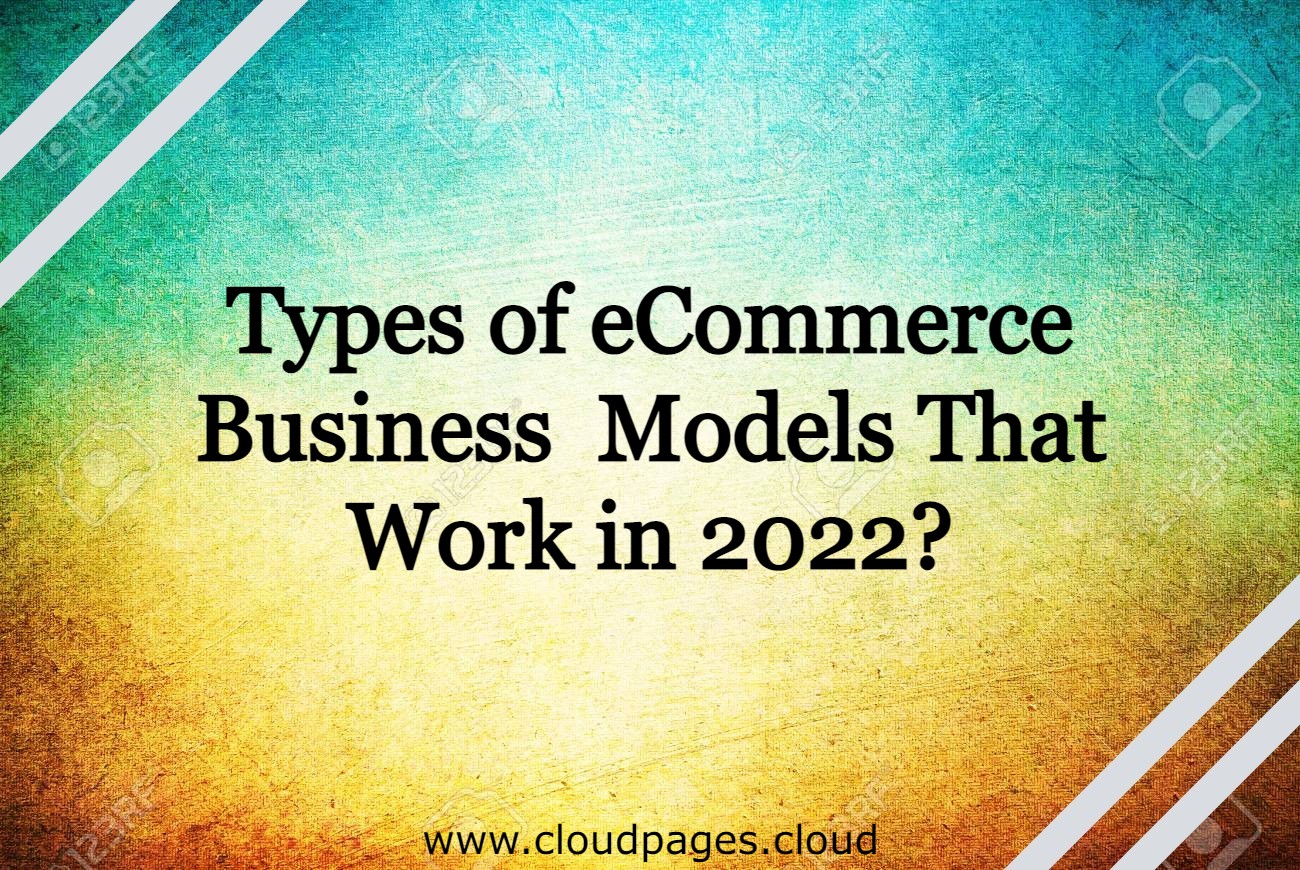Whether you’re a new or established e-commerce store owner, eCommerce business models are essential to ensure the profitability and value of your product. It simplifies branding aspects by measuring scalability and planning marketing tactics, giving you a competitive advantage in the market.
According to recent reports, eCommerce and online shopping trends will go up to 22% to 23% of the sales across the globe. Suppose you’ve just started to identify your eCommerce business model. In that case, it is vital in developing your company because it gives you identity and insights into your journey. However, suppose you’ve been here for a while. In that case, there isn’t any harm in keeping your business model updated and relevant to intuitive market trends.
Hence, this article sheds light on 6 types of eCommerce business models applicable to any online store or eCommerce shop in 2022.
Table of Contents
What is an e-commerce business model?
An eCommerce business model represents how your business functions to sell online goods and services. There are six major business models for e-commerce, as discussed in the sections below.
If you want to find a suitable e-commerce or internet business model, you need to figure out two aspects. Firstly, you have to define whom you’ll sell to and then describe how it’ll be positioned and what you want to sell.
Now, you need to identify your eCommerce business plan, which will describe how you’ll encourage customers and how they will get familiar with your product. Later, you need to figure out your delivery framework by assessing what will work best for your online business.
Types of eCommerce business models
Let’s dive into discussing the types of eCommerce or internet business models that will work in 2022:
1. Business-to-Business (B2B)
If the nature of products or services is headed toward meeting the needs of businesses, setting up a B2B strategy is a practical aspect for your brand. Social networking and reaching out are a bigger part of this strategy. A bigger advertising budget is not much help as the essential challenge you will face is convincing established businesses that your products or services are a great aspect of their processes.
The major benefit of this business model is that the size of your order is typically large, and repetitive orders are very common. And if you’ve maintained your product and service quality metrics.
2. Business-to-Consumer (B2C)
The B2C model is a specific adoption of your products or services targeted primarily towards individuals. Potential customers will visit your website to see if your product can address their major concerns, and vice versa.
After successfully browsing the store, the customer may decide to place an order on their WooCommerce store, i.e., Wholesale for WooCommerce.
3. Consumer-to-Consumer (C2C)

Although B2B and B2B business concepts are similar, Customer-to-Customer (C2C) is a concept unique to eCommerce. It is mainly due to the sheer demand of the platforms such as OLX, eBay, and Craigslist.
With this model, you can trade, purchase, sell, and rent out your products and services. The overall transactions on this platform receive a small portion of the commission. This business model is complicated and needs a proper plan to operate your business. Hence, most of the platforms have failed as per the legal issues.
4. Consumer to Business (C2B)
The Customer to Business (C2B) business model is a seamless and robust concept based on their platforms that cater to freelancers. In C2B, freelance workers tend to work on tasks provided by the clients. In the process of C2B, freelance workers tend to work on tasks provided by the clients. Most of these clients are commercial entities, and freelancers are often considered individuals. C2B is best thought of as a one-person business that works with large businesses, multinational companies, and corporate ventures.
Reversing the auction of your websites, freelance, and affiliate marketing ventures form this business model’s overall part. Furthermore, this model requires a complete plan based on the legal complexities.
5. Business to Government (B2G)
B2G is an online business model where businesses market their products to the public and law-enforcement agencies. But if you want to choose a business model, you will have to bid on public contracts and agreements. Governments can usually make requests for proposals, and e-commerce businesses then have to bid on public projects.
In several cases, a government agency won’t be liable for placing an order on your eCommerce website. However, some local public-sector agencies are considered exceptional cases for the applicable rule that depends on their needs and preferences.
6. Business to Business to Consumer (B2B2C)

Whenever business A sells products to business B, that business sells to the online consumers, and this strategic method is considered B2B2C eCommerce.
There are some resources involved in this type of online business model. For instance, if you want to go with it, you need to affiliate with another business. Later, you can sell its products and offer a partnership on commission for each sale.
The online store owners pick up this business model as per the acquisition of the new customer. It happens when the customers already know about the affiliate products. Nonetheless, they are unable to order them online due to obstacles such as geographical location, complex shipping costs, and vice versa.So, this model works well for new online store owners who want to reach a wider range of customers.
Aspects of Online eCommerce Promotion
Once you have a plan and a model, the next step is to choose the right ways to promote your business. These include:
- Affiliate Marketing
- Pay Per Click (PPC)
- Pay Per Lead (PPL)
- Pay Per Sale (PPS)
- Pay Per View (PPV)
- Pay Per Action (PPA)
- Native Advertising
- Pay Per Mile (PPM)
1. Affiliate Marketing
Affiliate marketing operates when you promote a product by another supplier or producer on your website or blog. Most e-commerce websites provide affiliate programs where users can sign up to become affiliates. For instance, your signup for the CloudPages High Paying Affiliate Program. When you get leads to CloudPages, you will earn a commission. Check out the comprehensive information on the working process of an affiliate program in conjunction with an affiliate page.
2. Pay Per Click (PPC)
Pay Per Click (PPC) is an eCommerce business model in which all the advertisers have to pay for each click that redirects to their product page. The business model is offered by affiliate marketing programs such as Max Bounty and Viral9.
3. Pay Per Lead (PPL)
Pay Per Lead (PPL) works identically to the PPC business model. The only distinguishing factor is that the promoters receive commission for the enormous amount of leads in a PPL plan. Lead Generation Programs, including Facebook Ads, Google Adwords, and Maxbounty, offer this plan.
4. Pay Per Sale (PPS)
Identical to the PPC business model, Pay Per Sale (PPS) enables publishers or promoters to earn a commission whenever they leverage sales for the advertising agency. This model is used by affiliate marketers, including Clickable, Shareasale, and Commission Junction.
5. Pay Per View (PPV)
Pay Per View (PPV) is a business model for an eCommerce store used to market YouTube, Facebook, Instagram, and Dailymotion videos. This platform is used as a computational factor for paying its users. A ‘view’ is often 10 seconds longer because that is considered the duration after Google advertises an ad.
6. Pay Per Action (PPA)
Pay Per Action (PPA) is a generic terminology in digital marketing. This model applies to all sorts of affiliate marketing elements, in which all the types of actions are expected of the visitors. Significantly, leads, sales, and clicks are classified as good results for PPA programs. Most affiliate programs use such actions as a tool to measure the unit of their campaigns. Maxbounty uses CPA or PPA marketing for all types of lead generation methods.
7. Native Advertising
Native ads are the newest way to market online. They became popular when Buzzfeed started putting promotional content in articles that looked natural. Such articles covered common topics but promoted brand products by mentioning them in passing without disrupting the flow. The readers won’t think that these are promotional articles as nothing regarding the context is written in the content. Native advertising costs vary based on multiple factors, such as content and website rankings. While routing to this path, you need to ensure the aspects raised by the Federal Trade Commission (FTC).
8. Pay Per Mile (PPM)
Pay Per Mile (PPM) is an aspect of computation used for displaying advertisements. Google Ads widely use it to pay users for every 1000 views. In terms of digital marketing, a mile is considered 1000 views. Hence, the rates for per mile marketing vary from one country to another. For instance, in Europe, the cost of PPM would be higher, whereas it would be on a lower scale in India.
Which eCommerce business model should you choose?
As you might have observed, there are multiple e-commerce models available in the marketplace. Each one has its own set of merits and demerits. The most preferred thing is to conduct an in-depth analysis of your business model and then pick the most suitable business model for your business.
If you need any sort of assistance, then please let us know in the comment section below. Don’t forget to subscribe to our newsletter for more in-depth blogs like this one.



